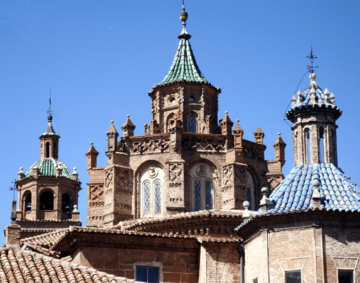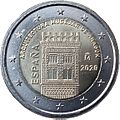Mudéjar architecture of Aragon facts for kids
| UNESCO World Heritage Site | |
|---|---|

Dome of the Cathedral of Teruel
|
|
| Location | Aragon (in Spain) |
| Includes | 10 sites in Teruel, Calatayud, Cervera de la Cañada, Tobed and Zaragoza |
| Criteria | Cultural: (iv) |
| Inscription | 1986 (10th Session) |
| Extensions | 2001, 2016 |
| Area | 4.269 ha (0.01648 sq mi) |
| Buffer zone | 20.063 ha (0.07746 sq mi) |
Mudéjar architecture of Aragon is a special kind of building style found in Aragon, a region in Spain. This unique style mixes Christian and Islamic art and building methods. Many important buildings showing this style have been named a World Heritage Site by Unesco.
This style was popular in Aragon from the 12th to the 17th century. You can find over a hundred buildings in this style, mostly along the Ebro, Jalón, and Jiloca river valleys.
Contents
What is Mudéjar Architecture?
Mudéjar architecture started in Aragon in two main ways. One way was through royal palaces, like the Aljafería Palace. This palace was changed and made bigger while keeping its beautiful Islamic decorations.
The other way was by changing how Romanesque architecture was built. Instead of using heavy stone blocks, builders started using bricks. They also added fancy patterns and designs, often inspired by Spanish traditions. You can see examples of this in churches in Daroca. These churches began with stone, but later parts were finished with Mudéjar brick designs in the 13th century.
Building Features and Design
Mudéjar buildings in Aragon often used ideas from Cistercian Gothic style, but with some changes.
Walls and Support
Many Mudéjar buildings do not have buttresses, which are supports built against walls. This is especially true for the apses (the rounded ends of churches). These apses often have eight sides and very thick walls. These thick walls are strong enough to hold up the roof without extra supports. They also provide lots of space for beautiful brick decorations.
However, buttresses are often seen on the main parts of the church, called the naves. Sometimes, these buttresses have small turrets (little towers) on top, like the Basilica of Our Lady of the Pillar.
Side Chapels and Walkways
Churches in neighborhoods or small towns usually do not have aisles (side passages). Instead, they have side chapels built between the buttresses of the nave. These chapels create spaces for extra altars.
It was also common for these side chapels to have a closed gallery or ándite. This was a walkway with windows that looked both outside and inside the building. This type of design made the church look like a "church-fortress." The church of Montalbán is a great example of this style.
Bell Towers
The bell towers in Mudéjar architecture are often very decorative. Their structure comes from Islamic minarets (towers used for calls to prayer). They usually have a square base with a central pillar. The spaces around this pillar are filled with stairs that use vaults (arched ceilings). This is similar to the style of Almohad architecture. On top of this square base, the tower usually becomes a polygon (a shape with many straight sides), or sometimes it is octagonal (eight-sided).
World Heritage Site Recognition

In 1986, Unesco recognized the Mudéjar buildings in Teruel as a World Heritage Site. This means they are considered very important to the world's history and culture. In 2001, the site was made bigger to include more Mudéjar monuments from Aragon.
Here are the ten sites that are part of the World Heritage list:
| Code | Name | Place | Year |
|---|---|---|---|
| 378-001 | Tower, roof and dome of the Cathedral of Saint Mary of Mediavilla | Teruel | 1986 |
| 378-002 | Tower and church of San Pedro | Teruel | 1986 |
| 378-003 | Tower and church of San Martín | Teruel | 1986 |
| 378-004 | Tower and church of The Savior | Teruel | 1986 |
| 378-005 | Apse, cloister and tower of Colegiata de Santa María | Calatayud | 2001 |
| 378-006 | Parish church of Santa Tecla | Cervera de la Cañada | 2001 |
| 378-007 | Church of Saint Mary | Tobed | 2001 |
| 378-008 | Mudéjar remains of the Palace of Aljafería | Zaragoza | 2001 |
| 378-009 | Tower and Parish church of San Pablo | Zaragoza | 2001 |
| 378-010 | Apse, parish and dome of La Seo | Zaragoza | 2001 |
Unesco explained why these sites are so important:
The Mudéjar art that grew in Aragon in the 12th century happened because of the political, social, and cultural situation in Spain after the Reconquista (when Christian kingdoms took back land from Muslim rule). This art was influenced by Islamic traditions, but it also showed styles from Europe, especially Gothic. It lasted until the early 17th century. It is known for its very skilled and creative use of brick and shiny tiles in buildings, especially on church towers.
—Aragonese Mudejar statement on the official website of UNESCO.
This means the sites are a great example of a type of building or group of buildings that show an important time in human history.
Images for kids
See also
 In Spanish: Arquitectura mudéjar de Aragón para niños
In Spanish: Arquitectura mudéjar de Aragón para niños


